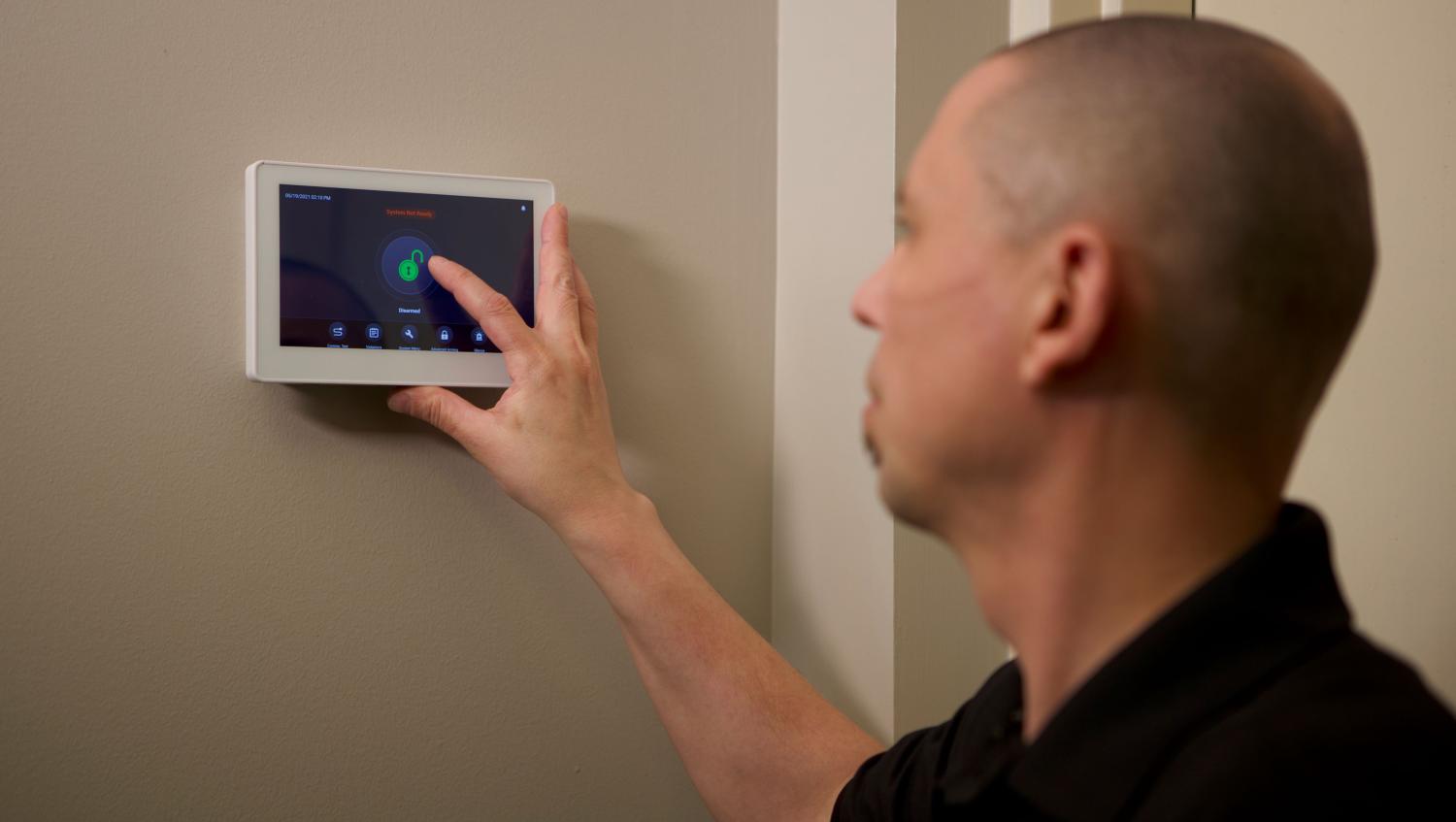Home>Home Security and Surveillance>What Is The Difference Between Intrusion Detection And Prevention?


Home Security and Surveillance
What Is The Difference Between Intrusion Detection And Prevention?
Modified: March 6, 2024
Learn about the key distinctions between intrusion detection and prevention in home security and surveillance. Stay informed to protect your property.
(Many of the links in this article redirect to a specific reviewed product. Your purchase of these products through affiliate links helps to generate commission for Storables.com, at no extra cost. Learn more)
Introduction
Home security and surveillance play a vital role in keeping our homes and loved ones safe. With the advancements in technology, there has been a significant increase in the use of intrusion detection and prevention systems. These systems are designed to detect and prevent unauthorized access to our homes, providing an added layer of security against potential threats.
Intrusion detection and prevention systems are often used interchangeably, but they actually serve distinct purposes. Understanding the difference between the two is crucial in selecting the right security solution for your home.
In this article, we will delve into the definitions of intrusion detection and intrusion prevention, explore the key differences between them, highlight their similarities, and discuss the benefits and challenges associated with using these systems. We will also touch on the integration of intrusion detection and prevention systems to provide a comprehensive approach to home security.
Whether you are a homeowner looking to enhance your security measures or a security professional seeking to broaden your knowledge, this article will provide valuable insights into the world of intrusion detection and prevention.
Key Takeaways:
- Intrusion detection systems (IDS) act like a security guard, alerting homeowners about potential threats, while intrusion prevention systems (IPS) are like a superhero, actively blocking and stopping intrusions in real-time.
- By combining IDS and IPS, homeowners can have a dynamic duo of security, with IDS providing early warnings and IPS taking immediate action to keep homes safe from cyber threats.
Read more: What Is The Difference Between Anomaly Detection And Signature-Based Intrusion Detection?
Definition of Intrusion Detection
Intrusion detection is a critical component of a home security system that focuses on identifying unauthorized access or activity in a network or physical environment. It is designed to detect and alert homeowners or security personnel about potential security breaches or suspicious behavior.
An intrusion detection system (IDS) monitors various elements within the home security system, including network traffic, physical entry points, and sensors. It analyzes these elements to identify patterns or anomalies that may indicate an intrusion or security threat. IDSs can use a combination of techniques such as signature-based detection, anomaly-based detection, behavior-based detection, and machine learning algorithms to spot potential intrusions.
Signature-based detection involves comparing network traffic or system events against a database of known signatures or patterns of malicious activity. Any match found triggers an alert to notify the homeowner or security personnel. This approach is effective in detecting known threats, but it may struggle to identify new or evolving attack methods.
Anomaly-based detection, on the other hand, establishes a baseline of normal activity within the home security system. It then monitors for deviations or abnormalities from this baseline. Any significant deviation that is outside the expected range can indicate a potential intrusion.
Behavior-based detection takes into account the behavior of users or devices within the home security system. It identifies unusual or unauthorized behaviors that may signal a security breach. For example, if a user suddenly starts accessing sensitive areas of the home that they don’t typically access, the behavior-based detection system can raise an alarm.
Machine learning algorithms are increasingly being employed in intrusion detection systems to improve accuracy and effectiveness. These algorithms analyze large amounts of data to automatically learn and adapt to new patterns of malicious activity. They can identify previously unknown or “zero-day” attacks based on their deviations from normal behavior.
Overall, intrusion detection serves as the first line of defense by actively monitoring for potential threats or unauthorized activity. It provides homeowners with timely alerts, allowing them to take appropriate actions to mitigate any potential security risks.
Definition of Intrusion Prevention
Intrusion prevention is a vital component of a comprehensive home security system that focuses on actively blocking or mitigating unauthorized access or malicious activity. It goes beyond simply detecting intrusions and takes proactive measures to prevent them from compromising the security of the home.
An intrusion prevention system (IPS) works in conjunction with intrusion detection systems to identify and respond to potential threats in real-time. It uses various methods and techniques to analyze incoming network traffic, identify suspicious patterns, and take appropriate actions to prevent the intrusion.
One of the primary approaches used in intrusion prevention is the use of firewalls. Firewalls act as a barrier between the internal network and the external internet, monitoring and controlling incoming and outgoing traffic. They apply predefined rules and filters to determine whether to permit or block specific connections or data packets. Firewalls can be set up to block known malicious IP addresses or to deny access to specific ports that are commonly targeted by attackers.
In addition to firewalls, intrusion prevention systems can employ intrusion detection techniques such as signature-based detection, anomaly-based detection, and behavior-based detection to identify malicious activity in real-time. Once a potential threat is detected, the IPS can take immediate action to block or terminate the malicious connection, preventing the intrusion from progressing further.
Another key aspect of intrusion prevention is the ability to perform packet inspection. By examining the contents of network packets in depth, an IPS can identify and block attacks at a granular level. This includes identifying and blocking specific types of malware, suspicious file attachments, or malicious URLs within network traffic.
Furthermore, intrusion prevention systems can proactively protect against common attack vectors such as Distributed Denial of Service (DDoS) attacks. They can detect and mitigate high volumes of traffic from multiple sources before it overwhelms the home network, ensuring continuous availability and preventing service disruption.
Overall, intrusion prevention systems play a crucial role in actively defending against potential security threats. By monitoring, analyzing, and taking proactive measures to block or mitigate intrusions, they enhance the overall security posture of the home environment and provide homeowners with peace of mind.
Key Differences between Intrusion Detection and Prevention
While both intrusion detection and intrusion prevention contribute to the overall security of a home, there are several key differences between the two. Understanding these differences is essential in selecting the right security solution for your specific needs. Let’s explore the main distinctions:
- Focus: Intrusion detection systems (IDS) primarily focus on identifying and alerting homeowners or security personnel about potential security breaches or suspicious activity. They serve as a passive monitoring tool to detect intrusions. In contrast, intrusion prevention systems (IPS) take a proactive approach by actively blocking or mitigating intrusions in real-time.
- Response: IDSs are designed to provide notifications and alerts when a potential intrusion is detected. They don’t directly take action to stop the intrusion. IPSs, on the other hand, respond to detected threats by blocking, terminating, or mitigating the malicious activity. They actively prevent intrusions from compromising the security of the home environment.
- Timeliness: IDSs focus on timely detection and notification of potential intrusions, allowing homeowners or security personnel to take appropriate action. They prioritize accuracy in detecting and reporting potential threats. IPSs prioritize real-time response and prevention, aiming to block or mitigate intrusions as quickly as possible. They prioritize speed and effectiveness in stopping intrusions in their tracks.
- Action: IDSs often rely on human intervention to analyze and respond to alerts generated by the system. Security personnel or homeowners need to manually assess the alerts and decide on the appropriate actions to take. IPSs, on the other hand, are designed to automate the response process. They can take immediate action, such as blocking malicious connections or terminating suspicious activities, without the need for human intervention.
- Risk tolerance: IDSs are typically used in environments where the focus is on detecting and monitoring potential threats rather than taking immediate action. They are useful for organizations or individuals who prefer a more conservative approach to security, allowing for careful assessment of potential threats before taking action. IPSs are suited for those who prioritize proactive protection and have a lower tolerance for risk. They place more emphasis on preventing intrusions and quickly mitigating potential damage.
By understanding these key differences, you can make informed decisions when selecting the right combination of intrusion detection and prevention systems to enhance the security of your home environment.
Similarities between Intrusion Detection and Prevention
While intrusion detection and intrusion prevention systems have distinct purposes and approaches, they also share several similarities in their overall goal of safeguarding homes against security threats. Here are some key similarities between the two:
- Security Enhancement: Both intrusion detection systems (IDS) and intrusion prevention systems (IPS) contribute to the overall enhancement of home security. They provide an additional layer of defense against unauthorized access and malicious activity.
- Monitoring Capabilities: Both IDSs and IPSs have monitoring capabilities that allow them to analyze network traffic, system events, and physical entry points to identify potential intrusions or security breaches. They constantly monitor the home environment for suspicious or anomalous behavior.
- Alerting Mechanisms: Both systems utilize alerting mechanisms to notify homeowners or security personnel of potential security threats. Whether it’s through email notifications, SMS alerts, or a central monitoring station, they ensure that timely information is provided to facilitate appropriate response and action.
- Data Analysis: Both IDSs and IPSs rely on advanced data analysis techniques to identify potential threats. They analyze network traffic patterns, system logs, and user behavior to detect anomalies or patterns indicative of malicious activity.
- Integration with Other Security Systems: Both systems can integrate with other security systems within the home, such as surveillance cameras, access control systems, and alarm systems. This integration allows for a more comprehensive security approach, leveraging the strengths of different systems to provide robust protection.
- Continuous Improvement: Both IDSs and IPSs can benefit from continuous improvement and updating. As new security threats emerge, the systems can be updated with the latest threat intelligence and detection techniques to stay ahead of evolving threats.
By recognizing these similarities, homeowners can appreciate the overlapping capabilities and benefits of intrusion detection and prevention systems, leading to a more comprehensive and effective approach to home security.
Benefits of Intrusion Detection Systems
Intrusion detection systems (IDS) offer several key benefits in enhancing the security of homes. Let’s explore some of the advantages of using IDS:
- Early Threat Detection: IDSs continuously monitor network traffic, system events, and physical entry points. They can quickly identify potential security breaches or suspicious activities, allowing homeowners to take prompt action and mitigate any potential damage.
- Alerts and Notifications: IDSs generate alerts and notifications when potential threats are detected. These alerts can be sent via email, SMS, or through a central monitoring station, keeping homeowners informed about potential risks and enabling them to respond promptly.
- Reduces Downtime: By detecting and addressing security incidents early on, IDSs help minimize system downtime. Prompt action can prevent the intrusion from escalating and causing significant disruption to home networks, devices, or services.
- Compliance Requirement: IDSs can assist in meeting regulatory and compliance requirements. For example, certain industries may be required to implement intrusion detection systems to protect sensitive data and ensure compliance with privacy regulations.
- Forensic Analysis: IDSs generate logs and records of security events, which can be invaluable for forensic analysis in the event of a security incident. These records provide valuable insights into the nature of the intrusion and help in identifying the potential source of the attack.
- Improved Incident Response: IDSs serve as an early warning system, enabling homeowners or security personnel to respond effectively to security incidents. With timely alerts and information, they can identify the affected systems and devices, isolate compromised areas, and implement appropriate countermeasures.
- Identify Network Vulnerabilities: IDSs can help identify potential vulnerabilities within the home network. By analyzing network traffic and system events, they can detect misconfigurations, outdated software versions, or weak security settings, allowing homeowners to address these weaknesses and strengthen the overall security posture.
- Enhanced Visibility: IDSs provide insights into network traffic and user behavior, giving homeowners a clearer understanding of what is happening within their home network. This visibility can help identify any abnormal or unauthorized activities and improve overall network management and control.
By leveraging the benefits of intrusion detection systems, homeowners can enhance their security measures, reduce vulnerability to potential threats, and gain peace of mind knowing their home is being actively monitored for potential intrusions.
Intrusion detection is like a security guard watching for intruders, while intrusion prevention is like a security system that stops intruders from getting in.
Benefits of Intrusion Prevention Systems
Intrusion prevention systems (IPS) offer several key benefits in effectively safeguarding homes against security threats. Let’s explore some of the advantages of using IPS:
- Real-time Threat Prevention: IPSs actively prevent intrusions by blocking or mitigating malicious activities in real-time. They analyze network traffic and system events and take immediate action against potential threats, significantly reducing the risk of security breaches.
- Proactive Defense: IPSs provide proactive defense mechanisms by automatically detecting and responding to security threats. They actively seek out and block unauthorized access attempts, malware attacks, and other malicious activities before they can compromise the home network or devices.
- Reduced Impact of Attacks: By blocking or mitigating security threats, IPSs minimize the impact of attacks on the home network, devices, and data. They limit the potential damage caused by intrusions and prevent the unauthorized extraction of sensitive information.
- Continuous Monitoring: IPSs provide continuous monitoring of network traffic, system events, and physical entry points. This proactive approach ensures that any unauthorized or malicious activities are immediately identified and responded to, reducing the window of opportunity for attackers.
- Protection Against Known and Unknown Threats: IPSs can defend against both known and unknown threats. They utilize various detection techniques, including signature-based detection, anomaly-based detection, and behavior-based detection. This ability to identify and respond to emerging threats helps to protect the home environment from evolving attack methods.
- Comprehensive Network Protection: IPSs protect the entire home network, including all connected devices and resources. They secure network traffic, detect and prevent intrusion attempts, and ensure that all devices connected to the network are safeguarded against potential threats.
- Improved Network Performance: By actively blocking malicious traffic and unauthorized access attempts, IPSs can improve network performance. They prevent bandwidth-consuming activities and reduce the risk of network congestion caused by distributed denial of service (DDoS) attacks.
- Simplified Security Management: IPSs offer centralized security management capabilities, allowing homeowners to have a consolidated view of their overall security posture. This simplifies the management and monitoring of security policies, rules, and updates, making it easier to ensure the effectiveness of the security measures.
By leveraging the benefits of intrusion prevention systems, homeowners can significantly enhance their security defenses. IPSs provide real-time threat prevention, proactive defense mechanisms, and continuous monitoring, ensuring a robust and resilient security environment for the home.
Challenges and Limitations of Intrusion Detection Systems
While intrusion detection systems (IDS) play a crucial role in enhancing home security, they also face various challenges and limitations. Understanding these limitations is important for homeowners to effectively utilize IDS and manage their expectations. Let’s explore some of the common challenges and limitations:
- False Positives: IDSs can generate false positive alerts, flagging legitimate activities as potential security threats. This can lead to alert fatigue and potentially impact the effectiveness of the system, as homeowners may start ignoring or overlooking genuine security incidents.
- False Negatives: Conversely, IDSs may also generate false negative alerts, failing to detect certain types of intrusions or security breaches. Sophisticated attackers can employ evasion techniques, bypassing the detection mechanisms and remaining undetected, posing a risk to the home environment.
- Complexity and Configuration: IDSs can be complex to configure and maintain, requiring expertise in network security and system administration. Proper tuning and configuration are necessary to minimize false positives and maximize the detection capabilities of the system.
- Network Encryption: IDSs may face challenges in detecting threats within encrypted network traffic. As more communication channels utilize encryption, such as Transport Layer Security (TLS), IDSs may struggle to analyze the content of encrypted packets, limiting their ability to detect potential intrusions.
- Performance Impact: IDSs can impact network performance, especially in high-traffic environments. The system’s analysis of network traffic and events consumes computing resources, potentially causing delays or bottlenecks. Proper hardware and resource allocation are necessary to minimize any performance impact.
- Emerging and Unknown Threats: IDSs primarily focus on detecting known threats based on predefined signatures or behavior patterns. They may struggle to detect emerging or unknown threats that do not match existing signatures or exhibit detectable anomaly behavior. Constant updating and fine-tuning of the system are necessary to address new and evolving threats.
- Insider Threats: IDSs may face challenges in detecting insider threats, where authorized individuals with legitimate access intentionally misuse their privileges. Identifying abnormal or unauthorized behavior from trusted users can be challenging and requires a deeper analysis of user activities and behaviors.
- Resource Constraints: IDSs often require substantial computing resources to analyze and process large volumes of network traffic and system events. Small-scale home environments with limited resources may face challenges in deploying IDSs with the necessary capacity to handle the workload effectively.
Despite these challenges and limitations, IDSs remain valuable tools in detecting potential intrusions and supporting overall home security measures. By understanding these limitations, homeowners can make informed decisions on system deployment, configuration, and integration with complementary security systems to optimize the effectiveness of intrusion detection.
Challenges and Limitations of Intrusion Prevention Systems
Intrusion prevention systems (IPS) provide proactive security measures to safeguard homes against potential threats. However, like any security solution, IPS also faces certain challenges and limitations. It is important for homeowners to be aware of these limitations in order to effectively manage their IPS and maximize its benefits. Let’s explore some common challenges and limitations of intrusion prevention systems:
- False Positives: IPSs can generate false positive alerts, mistakenly blocking legitimate network traffic or activities. This can disrupt normal operations and cause inconvenience for homeowners if genuine connections or activities are erroneously blocked.
- False Negatives: Conversely, IPSs may also produce false negative alerts, failing to detect certain types of intrusions or malicious activities. Sophisticated attackers can employ advanced evasion techniques, allowing them to bypass the IPS’s detection mechanisms undetected, posing a potential risk to the home network.
- Network Complexity: IPSs may face challenges in dealing with complex network environments. As home networks become more diverse, with a multitude of devices and communication channels, IPSs need to adapt to the evolving network infrastructure and effectively analyze traffic from all sources and protocols.
- Resource Consumption: IPSs require computing resources to analyze and process network traffic in real-time. This can result in increased resource consumption, potentially impacting network performance, especially in high-traffic environments. Proper resource allocation and optimization are necessary to balance security needs with network performance requirements.
- Encryption: Encrypted network traffic can pose a challenge for IPSs, as the content of encrypted packets cannot be easily inspected. As more communication moves towards encryption, such as Secure Sockets Layer (SSL) and Transport Layer Security (TLS), IPSs may struggle to detect and analyze threats within encrypted traffic.
- Emerging Threats: IPSs rely on known threat signatures and behavior patterns for detection. Therefore, they may face challenges in detecting new and emerging threats for which signatures and patterns have not yet been identified. Regular updates and threat intelligence integration are essential to address emerging threats.
- Configuration Complexity: Proper configuration of IPSs is crucial for optimal performance. However, understanding and configuring complex rule sets, policies, and filters can be challenging for homeowners without adequate knowledge and expertise in network security. Improper configuration may lead to ineffective threat detection or unnecessary blocking of legitimate traffic.
- Zero-Day Vulnerabilities: IPSs may have limitations in detecting zero-day vulnerabilities or previously unknown attack techniques. Zero-day vulnerabilities are vulnerabilities that have not yet been publicly disclosed or patched, making them difficult to detect and mitigate using signature-based detection alone.
Despite these challenges and limitations, intrusion prevention systems remain vital components in defending against potential security threats. By understanding the limitations and employing a multi-layered security approach, homeowners can effectively utilize IPSs to enhance the overall security of their home networks.
Integration of Intrusion Detection and Prevention Systems
The integration of intrusion detection systems (IDS) and intrusion prevention systems (IPS) can provide a comprehensive and effective approach to home security. By combining the strengths of both systems, homeowners can enhance their ability to detect, respond to, and prevent potential security threats. Let’s explore the benefits and considerations of integrating IDS and IPS:
Improved Threat Detection: IDSs excel in detecting potential intrusions and security breaches by monitoring network traffic, system events, and physical entry points. By integrating an IDS with an IPS, homeowners can leverage the IDS’s capabilities in identifying and alerting to suspicious activities, while the IPS can take proactive measures to block or mitigate the identified threats.
Real-time Response: Integrating an IPS with an IDS enables immediate response to detected threats. The IDS can alert homeowners or security personnel about potential intrusions, triggering the IPS to take immediate action in blocking the malicious activity. This real-time response helps to prevent further compromise of the home network and devices.
Reduced False Positives: IDSs can sometimes generate false positive alerts, flagging legitimate activities as potential threats. By integrating an IPS, which can validate the alerts generated by the IDS, homeowners can reduce the risk of false positives by allowing the IPS to verify and confirm the threat before taking action. This minimizes unnecessary interruption to normal operations.
Streamlined Security Management: Integration of IDS and IPS can provide a centralized management approach to home security. Homeowners can have a single interface to monitor and manage both systems, simplifying security management tasks such as rule configuration, policy updates, and threat intelligence integration.
Threat Intelligence Exchange: When IDS and IPS are integrated, they can share threat intelligence gathered from their respective analyses. This shared intelligence allows both systems to benefit from a better understanding of current threats and emerging attack methods, improving the accuracy and effectiveness of threat detection and prevention.
Continuous Improvement: Integrated IDS and IPS systems can be regularly updated and fine-tuned to adapt to evolving threats. As new threats emerge, security vendors can provide updates to the IDS and IPS systems, mitigating the risk of zero-day vulnerabilities and ensuring that the security measures remain effective over time.
Considerations: Integration of IDS and IPS systems requires careful planning and configuration. Homeowners should consider factors such as network architecture, system compatibility, and bandwidth requirements to ensure seamless integration and optimal performance. It is also important to regularly review and update policies and rules to align with changing security needs and emerging threats.
By integrating IDS and IPS systems, homeowners can create a comprehensive security framework that combines threat detection, real-time response, and proactive prevention. This integrated approach enhances the overall security posture of the home environment, safeguarding against potential intrusions and providing peace of mind.
Conclusion
Home security and surveillance are of paramount importance in today’s world, and intrusion detection and prevention systems play a crucial role in enhancing the security of our homes. By understanding the differences and similarities between these systems, homeowners can make informed decisions when selecting the right security solution for their specific needs.
Intrusion detection systems (IDS) focus on identifying potential intrusions and alerting homeowners or security personnel about suspicious activities. They serve as a passive monitoring tool, offering early threat detection and timely notifications. IDSs provide valuable insights into security events, facilitating incident response and forensic analysis.
Intrusion prevention systems (IPS), on the other hand, take a proactive approach by actively preventing intrusions from compromising the security of the home. IPSs analyze network traffic in real-time, block or mitigate potential threats, and reduce the impact of attacks by effectively addressing security incidents.
Both IDS and IPS systems have their own unique benefits as well as challenges and limitations. IDSs offer early threat detection, alerts and notifications, improved incident response, and enhanced visibility into network activities. On the other hand, IPSs provide real-time threat prevention, proactive defense mechanisms, and continuous monitoring to protect against known and unknown threats.
The integration of IDS and IPS systems provides a comprehensive and robust approach to home security. By combining the strengths of both systems, homeowners can improve threat detection, enable real-time response, reduce false positives, and streamline security management. The integration also facilitates the exchange of threat intelligence, ensuring that the systems stay up-to-date and adaptive to evolving security threats.
As homeowner’s security needs evolve, it is important to regularly review and update the intrusion detection and prevention systems in place. Continuous improvement, system maintenance, and staying informed about emerging threats and technologies are essential for maintaining effective home security.
In conclusion, intrusion detection and prevention systems are critical components of a comprehensive home security strategy. By leveraging these systems’ capabilities, homeowners can enhance their security posture, protect against potential intrusions, and create a safer environment for themselves and their loved ones.
Frequently Asked Questions about What Is The Difference Between Intrusion Detection And Prevention?
Was this page helpful?
At Storables.com, we guarantee accurate and reliable information. Our content, validated by Expert Board Contributors, is crafted following stringent Editorial Policies. We're committed to providing you with well-researched, expert-backed insights for all your informational needs.













